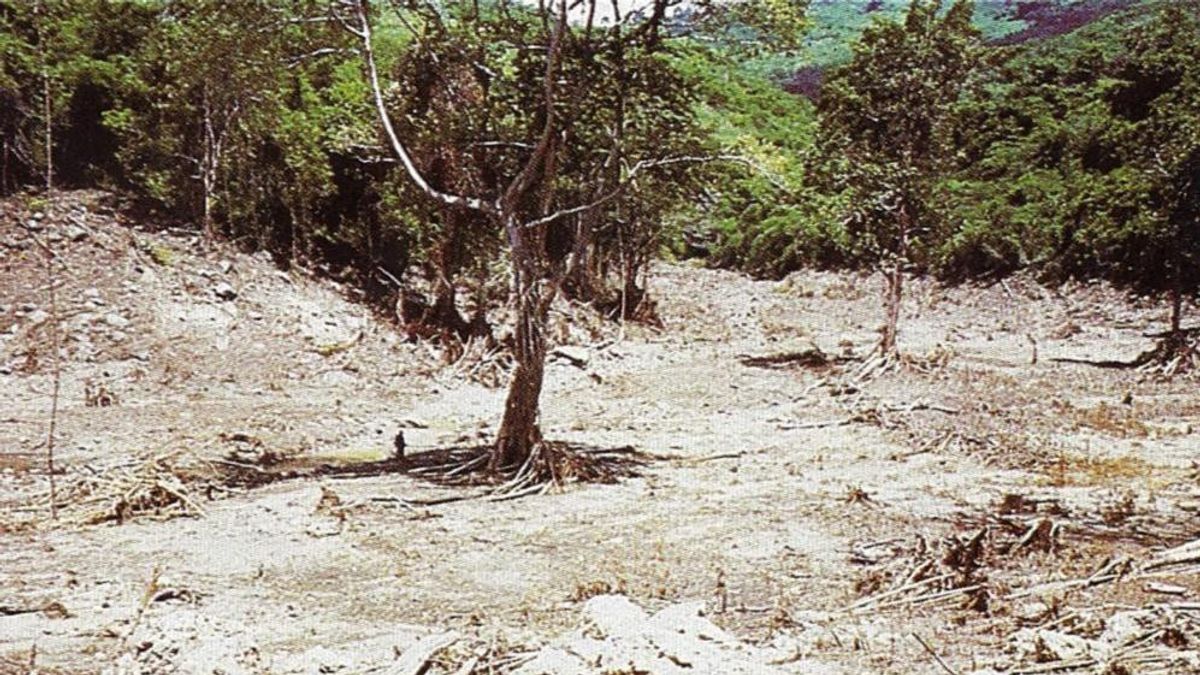JAKARTA - Meteorology, Climatology Agency. and Geophysics (BMKG) revoked the tsunami early warning in East Nusa Tenggara (NTT). Previously a warning was issued following an earthquake with a potential tsunami magnitude on Tuesday, December 14. Today's events remind us of the 'East of Tragedy', a similar disaster that hit the same area on December 12, 1992, 29 years ago.
"The #Tsunami Early Warning caused by the #Earthquake Magnitude: 7.4, 14-Dec-21 10:20:23 WIB, has been declared over #BMKG," wrote the BMKG on its Twitter, @infoBMKG reported by VOI, Tuesday, December 14.
In his explanation, the location of the earthquake was 113 km northwest of Larantuka-NTT. The public is asked to always follow the warning directions from BPBD, BNPB and BMKG.
Previously, people in East Flores Regency, NTT, scattered after being rocked by the earthquake on Tuesday, December 14 this afternoon. The earthquake is estimated to have occurred at around 10:45 WIT.
#Tsunami Early Warning caused by #Earthquake Magnitude: 7.4, 14-Dec-21 10:20:23 WIB, declared over #BMKG https://t.co/foNXUMzNoI
— BMKG (@infoBMKG) December 14, 2021

One resident in East Flores, Larantuka, Fransiskus Tukan said, the earthquake occurred in a short duration. "So at first it was felt very slowly but happened several times."
"Residents, including myself, are still calm with the strength of this small earthquake," said Frano, Francis' greeting when contacted by VOI from Jakarta, Tuesday, December 14. Frano continued, the strength of the earthquake increased suddenly and made residents panic, run and scatter out of the house. Almost in every house, residents look for a safe location by standing in the yard or city streets. "So this feels like a big earthquake. It's like sleeping well, you can feel it. From a small one, slowly, suddenly it becomes big. All residents run to the yard to avoid collapsing buildings or building materials," added Frano.
East of Tragedy: 1992 Flores earthquake and tsunami
The tsunami that started from an earthquake measuring 7.5 on the Richter scale on December 12, 1992 destroyed Flores. Thousands of casualties fell. Hundreds of places of worship were destroyed. The Flores people later remember this event as 'Doomsday at noon'.
The traces of Indonesia as the epicenter of the earthquake are present in many works and travel records of world celebrities. One of those who recorded it was the Lieutenant Governor of the Dutch East Indies, Thomas Stamford Raffles (1811-1816). During his leadership in the Land of Hope (Java), Raffles realized how earthquake-prone the archipelago was.
Raffles once wrote about the great earthquake in Batavia in 1699. The earthquake made Batavia's environment even more unhealthy. On another occasion, Raffles also mentioned the earthquake as one of the reasons why many popular temples in the archipelago were damaged.
For him, only tectonic forces on a large scale can fold the terrace of the temple building. The floor of the temple terrace is curved so that the stones of the stupa fall and are scattered on the terrace floor, like the picture of Borobudur when it was first rediscovered by Raffles.
“In addition to their statement about the two ruins of ancient objects, Brambanan (Prambanan) and Boro Bodo (Borobudur) are admirable objects as masterpieces. Some of the building areas are covered with beautiful plants. But the destruction has been happening slowly in some places. The shape is symmetrical and regular, many interesting characters can be seen on the existing sites and reliefs, which are full of ornaments and arouse curiosity today, but all of these have not been studied, sketched and explained, "said Thomas Stamford Raffles in his masterpiece, The History of Java (1817). ).

Unlike Raffles. Naturalist Alfred Russel Wallace, during his trip to the archipelago, recorded many earthquakes outside Java, to be precise in the eastern part of the archipelago. Alfred called the Eastern Archipelago as the most earthquake-prone area. This observation was recorded in his travel notes to Manado, Celebes (Sulawesi) in 1858.
Alfred often finds earthquakes of low scale and strong enough to shake buildings. In that context, Alfred even noticed the behavior of the local natives when an earthquake hit the area. The earthquake, said Alfred, was able to create both fear and amusement among the natives.
On the one hand, Alfred saw the earthquake could kill the lives of many people. On the other hand, the local bumiputras regard the earthquake as a game that requires them to race out of the house quickly.
“There was a mixture of fear and amusement during the earthquake. We were afraid of a stronger vibration that could make houses fall on us. Or what I'm more afraid of the earthquake will cause landslides. However, at the same time, it was hilarious to see us all rushing out every time there was a light vibration, then immediately reentered,” wrote Alfred Russel Wallace in his masterpiece, Archipelago Archipelago (2009).
Perhaps Alfred Russel Wallace called the earthquake disaster as a combination of tragedy and comedy. The assumption was because Alfred explored Indonesia in the period 1854-1862. His statement would be different if he directly felt the Flores earthquake and tsunami on December 12, 1992.
The earthquake with a large magnitude shook the Flores sea and brought deep sorrow to all its citizens. The Meteorology and Geophysics Agency recorded the magnitude of the earthquake at 6.8 on the Richter Scale.
However, the Institute de Physique du Globe geophysics institute based in Strasbourg, France, noted that the magnitude reached 7.5 SR. The Flores earthquake devastated four districts (Sikka, Ngada, Ende, and East Flores). After that, a large tsunami wave crushed small islands and several fishing villages. Noted, the death toll from the incident reached more than 2,400 people.

Apart from those killed, around 18,000 houses were destroyed, 113 schools were destroyed, 211 offices were heavily damaged, 120 places of worship (mostly churches) could not be used. Five main roads were also completely paralyzed. This series of facts made the Flores earthquake and tsunami the earthquake with the largest victims in history, before the Aceh Earthquake (2004) and Yogyakarta Earthquake (2006).
“Maumere, the heart and Capital of Sikka County, suffered the most. More than 10,000 houses were destroyed. The city has a population of about 20 thousand inhabitants. The pulse of economic activity there is currently in a coma, although that doesn't mean it's dead. Just look, how the old market near the port was destroyed. The shopping area is left in ruins and buildings fall down. The BRI office, hospital, and all other government buildings were badly damaged,” said Wahyu Muryadi and Zed Abidien in their article in Tempo Magazine entitled Disaster and Aid in Pulau Bunga (1992).
Maumere is practically a dead city. The earthquake disaster was getting worse because after that the tsunami wave hit Pulau Babi and Pulau Pamana Besar. The tsunami also swept across the face of two small islands with a total population of about two thousand people. Almost all residents are sucked in by water. Not only that, the great tsunami waves still crawled as far as 300 meters to the Maumere beach and hit the fishing village.
“Maumere suffered the most. About 1,100 people who died came from the poor fishing area. And hundreds of others suffered serious injuries. To the extent that the hospital in Maumere was forced to lay the flooded patients in the halls of the ward," wrote a Tempo magazine report entitled Kiamat Itu Bernama Earthquake (2018).
As a result, the survivors chose to build makeshift tents in the nearby hills. Moreover, after the earthquake and tsunami, many residents were deeply traumatized. Rescue workers moved quickly. The scattered bodies were immediately buried. There is one person buried in one hole.
There is also one hole filled by two to three people. Even then, the excavation of the grave cannot be too deep, because only half a meter has been dug, salt water has filled the hole. The event was later remembered as the Day of Judgment. Deep sorrow immediately enveloped the whole of Indonesia.
The Flores people, who were supposed to welcome Christmas in 1992 with joy, actually celebrate Christmas in mourning for the loss of their relatives and livelihood. To commemorate the incident, the metal band from Surabaya, Power Metal briefly summarized the sadness of the 1992 Flores earthquake and tsunami in a song entitled Timur Tragedi (1993).
East of tragedy
You are blind
Destroy property and objects
East of tragedy
Are you a sign?
Sometimes nature dares to be angry.
*Read other information about the HISTORY of the NUSANTARA or read other interesting articles from Bagus Santosa and Detha Arya Tifada.
Other BERNASThe English, Chinese, Japanese, Arabic, and French versions are automatically generated by the AI. So there may still be inaccuracies in translating, please always see Indonesian as our main language. (system supported by DigitalSiber.id)








